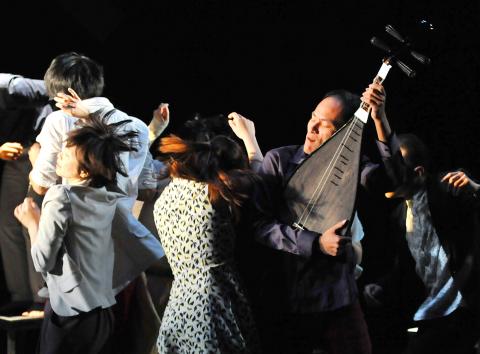One of the challenges to creating new works for the theater or dance is pushing boundaries and collaborations with artists from different spheres, whether it is incorporating multi-media elements, sculptural installations or set pieces or different musical genres into the production. Sometimes the mix and mash work, sometimes they don’t, but you have to be willing to experiment.
Dancer/choreographer Lin Wen-chung (林文中) has always been willing to challenge himself, his dancers and his audience, going against the grain and expectations of modern dance.
Almost three years ago, he premiered a new work for his WCdance (林文中舞團) company, Small Nanguan (小南管) at the Experimental Theater, that seamlessly blended together Western modern dance technique and traditional nanguan (南管) music.

Photo: Mandy Cheng, AFP
The performance captured the journey that he and his dancers, all of whom had grown up listening to Mandarin/Taiwanese pop and Western classical music, had gone on as they learned about nanguan, which none of them were familiar with. The production was captivating, reflecting Lin’s newfound appreciation and enjoyment of this classical Taiwanese/Chinese art form.
Asked to create a new production for the Experimental Theater for this year’s Taiwan International Festival of Arts, Lin decided to revisit nanguan, but move beyond the confines of his first work, where the musicians played their instruments to the side of the wooden platform that served as a dance stage and the dancers danced.
For Small Nanguan 2 (慢搖‧滾) Lin wanted to eliminate the distinctions between the dancers and the musician/singers to form a unified group that would dance, play instruments and sing.
He brought together dancers, musicians and members of the Ka Dao Yin (卡到音). Improvisational group, and spent several months jamming in a studio, seeking to break down the barriers between the two different types of artists and loosening the ties that bind the music to specific theatrical confines.
The idea was not to deconstruct nanguan, but add its elements of its rhythm and gestures into modern dance, a new combination of East and West.
It is a good idea in theory, but in the end the 70-minute production served more to prove that not all hybrids work. The slow pacing and musical structure of nanguan are not easily integrated into modern dance and the use of non-dancers, graceful though they may have been, reduced the scope of the choreography.
I am still trying to figure out how the piano solo, which moved from post-modern dissonance into jazzy riffs into a classical interlude, was meant to fit in or what Lin was trying to symbolize at the end when he stripped off his clothes, clutched a pipa to his chest and walked into darkness.
Tomorrow night the company will perform Small Nanguan 2 at Chunghsing Concert Hall (國立臺灣體育運動大學中興堂), 291-3 Jingwu Rd, Greater Taichung (台中市精武路291之3號) and on Saturday it will appear at the Wei Wu Ying Center of the Arts (高雄縣衛武營藝術文化中心) in Greater Kaohsiung (高雄市鳳山區南京路449之1號). Tickets for both shows are NT$400 and available through www.artsticket.com.tw or 7-Eleven’s ibon kiosks.

On April 26, The Lancet published a letter from two doctors at Taichung-based China Medical University Hospital (CMUH) warning that “Taiwan’s Health Care System is on the Brink of Collapse.” The authors said that “Years of policy inaction and mismanagement of resources have led to the National Health Insurance system operating under unsustainable conditions.” The pushback was immediate. Errors in the paper were quickly identified and publicized, to discredit the authors (the hospital apologized). CNA reported that CMUH said the letter described Taiwan in 2021 as having 62 nurses per 10,000 people, when the correct number was 78 nurses per 10,000

As we live longer, our risk of cognitive impairment is increasing. How can we delay the onset of symptoms? Do we have to give up every indulgence or can small changes make a difference? We asked neurologists for tips on how to keep our brains healthy for life. TAKE CARE OF YOUR HEALTH “All of the sensible things that apply to bodily health apply to brain health,” says Suzanne O’Sullivan, a consultant in neurology at the National Hospital for Neurology and Neurosurgery in London, and the author of The Age of Diagnosis. “When you’re 20, you can get away with absolute

May 5 to May 11 What started out as friction between Taiwanese students at Taichung First High School and a Japanese head cook escalated dramatically over the first two weeks of May 1927. It began on April 30 when the cook’s wife knew that lotus starch used in that night’s dinner had rat feces in it, but failed to inform staff until the meal was already prepared. The students believed that her silence was intentional, and filed a complaint. The school’s Japanese administrators sided with the cook’s family, dismissing the students as troublemakers and clamping down on their freedoms — with

As Donald Trump’s executive order in March led to the shuttering of Voice of America (VOA) — the global broadcaster whose roots date back to the fight against Nazi propaganda — he quickly attracted support from figures not used to aligning themselves with any US administration. Trump had ordered the US Agency for Global Media, the federal agency that funds VOA and other groups promoting independent journalism overseas, to be “eliminated to the maximum extent consistent with applicable law.” The decision suddenly halted programming in 49 languages to more than 425 million people. In Moscow, Margarita Simonyan, the hardline editor-in-chief of the